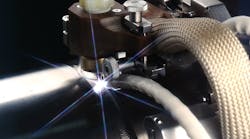Quality pays off.
For example, nobody would equip a Formula 1 racing car with inexpensive, all-weather tires. In order to achieve a competitive speed, the vehicle should lie optimally on the track and be perfectly matched to the respective track conditions.
Even with TIG arc welding, the tool used for high-quality welds must be adapted to the respective application—and yet many welders use second-class tungsten electrodes that are not matched to the respective process. This choice leads to a deterioration in the welding results due to low electrode quality.
However, efficient orbital welding requires a tungsten electrode with an individually adapted tip geometry and surface roughness to match the correct shielding gas.
For optimal weld seams, other factors must also be taken into account that influences the arc start properties, arc stability, total heat input, and correspond to the characteristics of the weld seam.
The adaptation of all parameters to the respective TIG application enables a service life that is up to six times longer and saves more than 350% compared to the use of non-specific no-name electrodes.
Yet, this can only be achieved with the appropriate know-how, the correct selection, and the use of high-quality tungsten.
Three central elements can be optimized in this way: the welding process itself, the chemical properties of the tungsten alloy used, and the grinding process for the electrode tip.
Increasing Demands on the Welding Process
In today's industrial environment, many manufacturers and processors of metal tubes and pipes are faced with stricter requirements for weld seam properties than was the case in the past.
The semiconductor industry needs narrower weld seams with fine surfaces on the inside of stainless steel pure gas pipes. These tubes transport high-purity gases that are toxic, flammable or corrosive, which is why the weld seams produced using the fusion welding process must be corrosion-resistant and cleanly processed in order to enable trouble-free flow.
In addition, designers from all technical disciplines are increasingly pushing the limits of technical feasibility by reducing pipe wall thicknesses to the necessary minimum. The clean processing of the weld seams is, therefore, becoming increasingly important with regard to the safety and service life of the products.
As the industry continues to evolve and adapt its processes, welders are also finding that their entire work environment is subject to high competitive pressure. Using Failure Mode and Effects Analysis (FMEA) and data analysis of the process variables, the previously underestimated hidden costs when using orbital systems were identified—the production of scrap, reduction in system availability, and frequent replacement of the electrodes.
This drives the total cost of ownership up, although at the same time it would save as much money as possible. This includes avoiding premature wear of the tungsten electrode and irregularities in the machining process that can result from the use of different tungsten alloys when using electrodes from different manufacturers.
Proper Chemistry Through Powder Metallurgy
Another important element for the quality of an electrode is its chemical composition.
To improve electrode performance, dopants in the form of cerium, lanthanum, zirconium, thorium, terbium, and yttrium oxides are often incorporated into tungsten electrodes. Such oxides lower the electron work function—measured in electron volts (eV).
To illustrate, pure tungsten has a rating of 4.5 eV, whereas a 2% ceriated tungsten has an eV of 2.8. By lowering the eV value or increasing the ionization potential, the oxides improve arc starting performance and arc stability.
Regardless, the influence of this variable on the welding result is often underestimated and most companies consider the tungsten electrode as a static component. In fact, as soon as the welding current flows, the electrode becomes a dynamic subsystem, the parameters of which influence the properties of the arc significantly.
Specifically, the heat of the welding arc causes oxides to migrate from the relatively cooler core of the electrode to the hotter tip. There, the oxides separate (evaporate) from the base element and leave a film on the electrode tip.
Small tolerances in the grain size, the purity of the elements, and the composition ratio are essential to ensure a consistent oxide movement and evaporation rate, which in turn leads to consistently high ignitability.
Because the melting points of the materials used for the electrodes can vary substantially—tungsten melts at 3,422°C, cerium oxide at 2,400°C—the electrode manufacturers rely on the powder metallurgy process.
Precise, extremely fine tungsten grain sizes are mixed in order to achieve a homogeneous oxide distribution in the matrix. After this process, the tungsten and the oxide powder are pressed together by isostatic pressure, so that a uniform density and microstructure are created. As a result, the brittle and unconsolidated electrodes are sintered for several hours in a high-purity hydrogen environment and at controlled temperatures.
After sintering, the electrodes can be forged to their final shape, which further optimizes the grain structure. The complexity of the tungsten electrode manufacturing process offers many opportunities for error, which explains the performance and cost differences between brands. Therefore, extensive know-how about the electrode is required on the one hand, but also extensive knowledge of the area of the application itself, on the other hand, in order to be able to optimally adapt the tool for the respective process.
Grinding for a Smooth Finish
Geometry also plays a critical role in tungsten electrode performance. It is significantly influenced by the grinding method used. For instance, the surface is increased by abrasives with a coarse grain, which in turn ensures faster oxide evaporation. Furthermore, the roughness of the surface when processing with a coarse-grained abrasive varies from application to application.
Hand-operated and bench tungsten grinders are best left for preparing electrodes for manual GTAW applications, not mechanized processes. In an orbital TIG arc welding system with a modern power source with inverter and good arc start behavior, companies should use pre-ground tungsten electrodes that have been machined by robot-controlled CNC systems. These machines are able to produce the desired very fine surfaces.
In order to influence boundary layers, voltage drop, cathode spots, evaporation rate or the relative exposed functional surface, the surfaces can be Ra 0.01 µm (0.4 microinches) low, with high edge sharpness of the contour or 3.2 µm (125 microinches) with perfectly burr-free flanks.
High-quality, pre-ground electrodes made of tungsten also offer a dimensional accuracy of ± 0.05 mm at the tip diameter and grinding angle tolerances of ± 1 degree. On the other hand, if a manual grinding machine is used to flatten the end of a pointed electrode, this leaves a microscopic burr without exception. If this burr breaks off during welding, it can get into the weld seam.
For pharmaceutical, medical, nuclear, aerospace-related, and other critical applications, this often means that the workpiece has to be sorted out. To complicate matters, electrode point geometry affects the plasma cone’s shape, which has an effect on the weld bead profile.
Outlook on Current Research Results
Much of the previous plasma research in the field of electrode geometry is carried out using the spot-on-plate technique (welding spot on a plate), in which an arc strikes a plate at 200 amps for two seconds. This technique does not represent the fluid dynamics (molten weld puddle behavior) that occur during orbital welding. It does not take into account the welding head that moves into the cold material from the weld seam, nor does it take into account the thermal conductivity and the preheating of the tube during the welding process.
Newer research, conducted under actual orbital welding conditions, incorporated more than 500 electrode configurations. Polished cross-sections of the welds were examined with a scanning electron microscope. Based on these results, suppliers of the electrode and orbital systems can now recommend suitable tungsten solutions for specific applications.
Narrow welds with a weld seam of 2 millimeters in outer diameter benefit from the increasing and constant arc pressure from the tungsten electrode, which is achieved by a mixture of mixed oxides, in which different oxide properties are combined.
These research results also help to solve previously hidden problems.
Recurring deviations in the welding process at a company led to a significantly higher reject rate. To reduce this, extensive measures have been taken to find the cause. The investigation team re-calibrated the power source and welding head and inspected every point in the circuit. This did not improve the welding results though.
However, the team never thought of the consumable component in the circuit: the electrode. The change to higher quality, pre-ground tungsten electrodes solved the problem.
Depending on the respective operating conditions, cumulative deviations caused by these factors can easily lead to a total heat input that deviates by as much as 5% under otherwise identical ambient conditions. While that might be acceptable now, it won’t likely be acceptable within the next decade when end-users require component fabricators to provide more complete data records and analytics.
Conclusion: High-Quality Tungsten Electrodes Optimize Cost-Efficiency
With every orbital welding process, high-quality electrodes reduce the overall welding costs. Test runs under cleanroom conditions confirm that with optimized tungsten electrodes, more than 650 arc starts can be easily implemented without delays in arc development. Instead of changing the electrode at the start of every shift, welders can use an electrode for several days.
For example, one company recorded an arc duration of 27 hours with a single electrode. Conversely, unspecific, second-class tungsten electrodes only deliver an average of about 110 arc starts and therefore have to be changed significantly more frequently. The associated labor cost alone wipes out any money saved on the purchase price.
Taking into account scrap and welding defects, it is therefore desirable to carefully select an electrode. This is the only way to produce high-quality weld seams that are still cost-effective.












